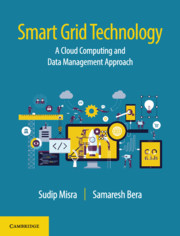Book contents
- Frontmatter
- dedication
- Contents
- Figures
- Tables
- Foreword
- Preface
- Part I Introduction
- 1 Introduction to Smart Grid
- 2 Introduction to Cloud Computing
- 3 Introduction to Big Data Analytics
- 4 Fundamental Mathematical Prerequisites
- Part II Cloud Computing Applications for Smart Grid
- Part III Smart Grid Data Management and Applications
- Part IV Smart Grid Design and Deployment
- Index
1 - Introduction to Smart Grid
from Part I - Introduction
Published online by Cambridge University Press: 20 October 2018
- Frontmatter
- dedication
- Contents
- Figures
- Tables
- Foreword
- Preface
- Part I Introduction
- 1 Introduction to Smart Grid
- 2 Introduction to Cloud Computing
- 3 Introduction to Big Data Analytics
- 4 Fundamental Mathematical Prerequisites
- Part II Cloud Computing Applications for Smart Grid
- Part III Smart Grid Data Management and Applications
- Part IV Smart Grid Design and Deployment
- Index
Summary
A smart grid is conceptualized as the existing power grid supported by bi-directional communication networks. Therefore, with the help of communication networks, service providers have real-time information about energy supply and demand. Moreover, customers also have real-time price information, based on which they can consume energy in an optimized manner, so that the total energy consumption cost is reduced. In addition to communication networks, several distributed energy generation units (such as solar, wind, and combined heat power) are also integrated to deploy distributed energy management policies. These distributed units are known as micro-grids. Typically, a smart grid consists of the following components – micro-grid, smart meter, renewable energy sources, and plug-in hybrid electric vehicles (PHEVs) [1]. Figure 1.1 depicts a schematic view of the smart grid architecture. Table 1.1 presents the basic differences between the traditional power grid and the smart grid.
Smart Grid Framework and Communication Model
Smart grid framework was initially conceptualized by the National Institute of Standards and Technology (NIST) in 2009. Figure 1.2 shows the smart grid framework conceptualized by NIST in its framework version 1.0 (adopted from [2]). The smart grid framework includes several entities – operators, markets, customers, utility providers, generation units, transmission units, and distribution units. The role of operators includes monitoring of the overall smart grid system and implementation of policies, while considering the interests of other entities. On the other hand, utility providers act as middle-persons between the customers and the energy markets. Therefore, it is possible to
Distribution side includes local substations and customers. Further, the local substations are built with modern technologies to integrate energy from the main power grid with energy generated locally at the substation in a distributed manner. Therefore, the power supply to the customers is done in a semidistributed manner. The local substation reports to the main power grid about the local energy generation and demand from the customers.
Customers’ homes are equipped with ‘smart meters,’ which send the energy consumption report to the substations. Further, the appliances installed at the customers’ ends are connected to the smart meters, in order to have smart energy monitoring system.
- Type
- Chapter
- Information
- Smart Grid TechnologyA Cloud Computing and Data Management Approach, pp. 3 - 17Publisher: Cambridge University PressPrint publication year: 2018



